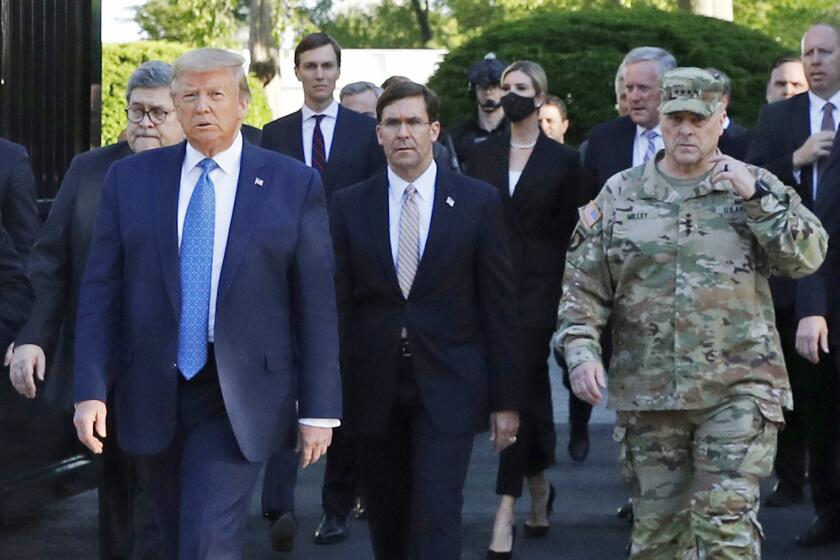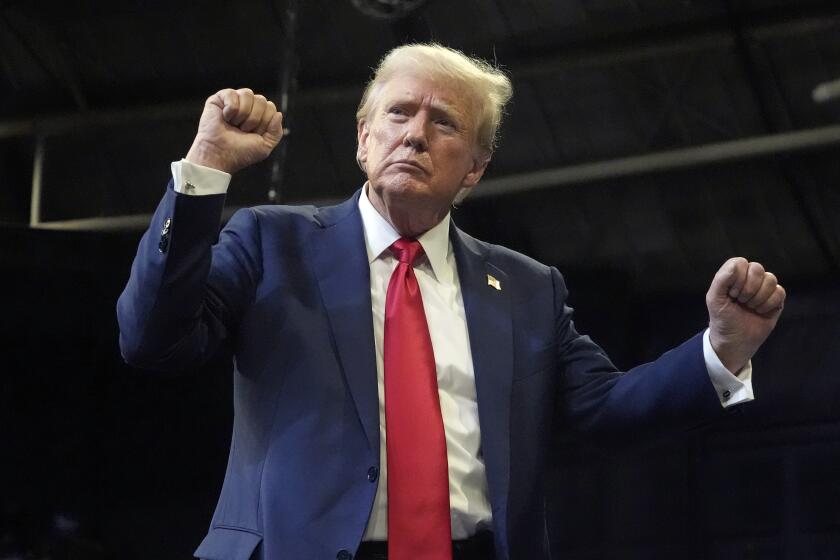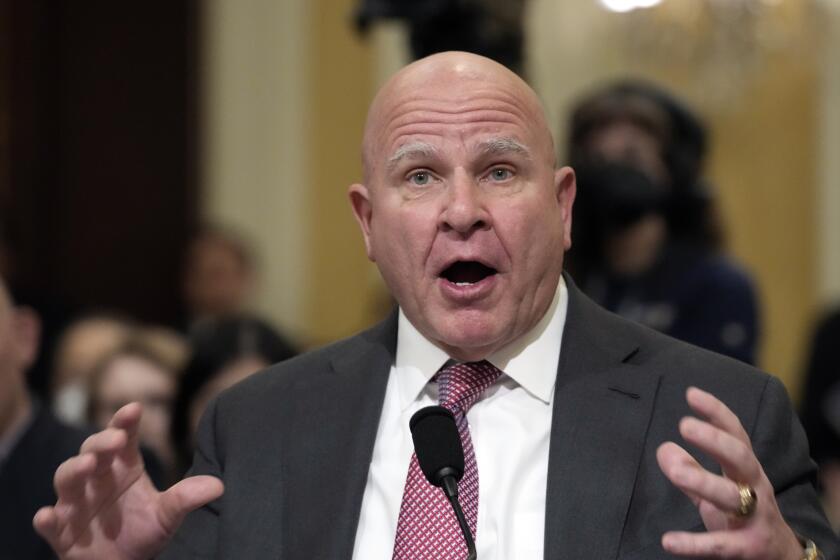Everyone who grasps the risk of nuclear war says Trump shouldn’t be trusted

- Share via
It was a mistake to visit Los Alamos in the middle of a presidential campaign that Donald Trump might win. I get that now, after wandering around the New Mexico town that is synonymous with clichés like “cautionary tale” and “Pandora’s box” and “be careful what you wish for.”
The shadow over the Manhattan Project — the undeniable feat of scientific brainpower that gave us the nuclear bomb — is apparent nine miles from this haunting town, in a roadside protest sign that quotes Pope Francis speaking five years ago in Hiroshima: “The possessing of nuclear weapons is immoral.” It is apparent in a video at the local history museum, as scientists reflect on their work with ambivalence and pride — regretful that Japanese leaders were not offered the chance to see a demonstration of a nuclear bomb and perhaps surrender before two cities were destroyed; thankful that after President Franklin Roosevelt’s death, President Truman followed through with the plan to use the bombs that ended World War II.
Military folks know that the former chairman of the joint chiefs is correct in calling the former president “fascist to the core” and “the most dangerous person to this country.”
Truman could have stopped it. He didn’t, but right afterward he ordered that presidential permission was required for such action, and his administration made it official policy in a 1948 memo: U.S. presidents had the sole authority to launch nuclear weapons. If a president gives the word, the military must obey. That’s even if America has not been attacked, and even if a president is demonstrably unfit. A president, for instance, such as Trump, whose reckless, divisive term ended with his loyalists — at his urging — staging a deadly attack on the Capitol to try to keep him in power after he lost the 2020 election.
The former president’s pathological lying, incoherence and memory problems should be front and center in the campaign for the White House.
“President Trump’s last terrifying weeks in office have been a wake-up call. Never again should we allow a dangerous president to have unilateral control over nuclear launch,” Sen. Elizabeth Warren and former Defense Secretary William J. Perry wrote in USA Today shortly after the mob rioted at the Capitol on Jan. 6, 2021. Trump wasn’t the first president to raise such concerns, they said, nor would he be the last. They called for ending “this godlike power” for all presidents to come.
But presidents still have it. And Trump is now trying for a second term in a race most analysts consider too close to call — a prospect so disturbing that this week more than 700 current and former national security officials signed a bipartisan letter endorsing his opponent, asking Americans to vote for Vice President Kamala Harris because Trump is “impulsive and ill-informed.” Just days earlier, more than 100 former Republican national security officials warned in a similar Harris endorsement that Trump’s erratic nature “threatens reckless and dangerous global consequences.”
National security advisors, Cabinet members and other Trump White House VIPs need to join others saying directly that their former boss is unfit for a second term.
A volatile temperament is one of the many reasons Trump is a national security menace. As Hillary Clinton memorably noted in her 2016 convention speech accepting the Democratic nomination: “A man you can bait with a tweet is not a man we can trust with nuclear weapons.”
Trump has already made America less safe. In his one term, he destroyed three nuclear agreements by unilaterally pulling the U.S. out, and he refused to extend the 2010 New Strategic Arms Reduction Treaty (a position President Biden reversed). Historian Lawrence S. Wittner, author of “Confronting the Bomb,” warned in July that “Trump was far less interested in arms control and disarmament than in entering ― and winning ― a new nuclear arms race.”
This was full circle from President Carter’s single term 40 years earlier, in the midst of the Cold War. He signed the second Strategic Arms Limitation Talks treaty (SALT II) with the Soviet Union in 1979 and told Congress that “every president” since the end of World War II “has sought to reduce the most dangerous elements of the Soviet-American competition.” Three of those presidents were Democrats and three were Republicans. This was a bipartisan project for decades, both before and after Carter.
But President George W. Bush withdrew from the Anti-Ballistic Missile Treaty in 2001, and 15 years later came Trump. We need to get back to reducing the risk of nuclear war. However, says author Steve Olson, who wrote about the Manhattan Project’s plutonium reactors in “The Apocalypse Factory,” “that is not going to happen with any Republican administration if Republicans continue on their current path.”
How about sending them on a field trip to Los Alamos? The Bradbury Science Museum there features a short film called “Racing Toward Dawn,” an allusion to the dawn of the atomic era. It recounts the two nuclear bombs dropped on Hiroshima and Nagasaki on Aug. 6 and 9, 1945, respectively.
“The Manhattan Project had unleashed a force never before seen,” the narrator says. “Each strike claimed tens of thousands of lives and left the cities in ruins. The devastation of these attacks, along with the Soviet entry into the war on Aug. 8, compelled the Japanese to surrender.” The war ended on Aug. 14. More than 50 million people had died because of the conflict. And the lab at Los Alamos moved on to improving atomic weapons, described in the film as “refining the nation’s nuclear deterrent.”
What happened at Los Alamos was both a triumph and a tragedy. What’s inarguable is that “nuclear deterrent” is a nerve-racking concept, especially if voters once again hand the “godlike power” to launch a nuclear strike to Donald Trump.
Jill Lawrence is a writer and author of “The Art of the Political Deal: How Congress Beat the Odds and Broke Through Gridlock.” @JillDLawrence









